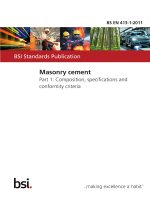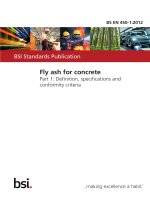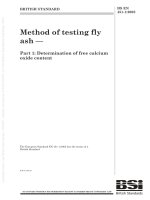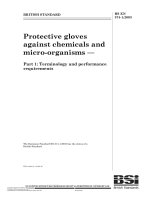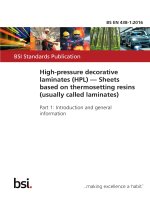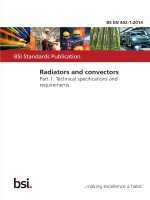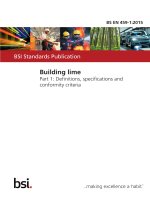Bsi bs en 61969 1 2012
Bạn đang xem bản rút gọn của tài liệu. Xem và tải ngay bản đầy đủ của tài liệu tại đây (1.08 MB, 16 trang )
BS EN 61969-1:2012
BSI Standards Publication
Mechanical structures for
electronic equipment —
Outdoor enclosures
Part 1: Design guidelines
BRITISH STANDARD
BS EN 61969-1:2012
National foreword
This British Standard is the UK implementation of EN 61969-1:2012. It is
identical to IEC 61969-1:2011. It supersedes BS EN 61969-1:2000 which is
withdrawn.
The UK participation in its preparation was entrusted to Technical Committee
EPL/48, Electromechanical components and mechanical structures for
electronic equipment.
A list of organizations represented on this committee can be obtained on
request to its secretary.
This publication does not purport to include all the necessary provisions of a
contract. Users are responsible for its correct application.
© The British Standards Institution 2012
Published by BSI Standards Limited 2012
ISBN 978 0 580 67585 0
ICS 31.240
Compliance with a British Standard cannot confer immunity from
legal obligations.
This British Standard was published under the authority of the Standards
Policy and Strategy Committee on 29 February 2012.
Amendments issued since publication
Amd. No.
Date
Text affected
BS EN 61969-1:2012
EUROPEAN STANDARD
EN 61969-1
NORME EUROPÉENNE
February 2012
EUROPÄISCHE NORM
ICS 31.240
Supersedes EN 61969-1:2000
English version
Mechanical structures for electronic equipment Outdoor enclosures Part 1: Design guidelines
(IEC 61969-1:2011)
Structures mécaniques pour équipement
électronique Enveloppes de plein air Partie 1: Lignes directrices pour la
conception
(CEI 61969-1:2011)
Mechanische Bauweisen für elektronische
Einrichtungen Außengehäuse Teil 1: Konstruktionsleitfaden
(IEC 61969-1:2011)
This European Standard was approved by CENELEC on 2011-12-22. CENELEC members are bound to comply
with the CEN/CENELEC Internal Regulations which stipulate the conditions for giving this European Standard
the status of a national standard without any alteration.
Up-to-date lists and bibliographical references concerning such national standards may be obtained on
application to the CEN-CENELEC Management Centre or to any CENELEC member.
This European Standard exists in three official versions (English, French, German). A version in any other
language made by translation under the responsibility of a CENELEC member into its own language and notified
to the CEN-CENELEC Management Centre has the same status as the official versions.
CENELEC members are the national electrotechnical committees of Austria, Belgium, Bulgaria, Croatia, Cyprus,
the Czech Republic, Denmark, Estonia, Finland, France, Germany, Greece, Hungary, Iceland, Ireland, Italy,
Latvia, Lithuania, Luxembourg, Malta, the Netherlands, Norway, Poland, Portugal, Romania, Slovakia, Slovenia,
Spain, Sweden, Switzerland, Turkey and the United Kingdom.
CENELEC
European Committee for Electrotechnical Standardization
Comité Européen de Normalisation Electrotechnique
Europäisches Komitee für Elektrotechnische Normung
Management Centre: Avenue Marnix 17, B - 1000 Brussels
© 2012 CENELEC - All rights of exploitation in any form and by any means reserved worldwide for CENELEC members.
Ref. No. EN 61969-1:2012 E
BS EN 61969-1:2012
EN 61969-1:2012
-2-
Foreword
The text of document 48D/488/FDIS, future edition 2 of IEC 61969-1, prepared by SC 48D, "Mechanical
structures for electronic equipment", of IEC/TC 48, "Electromechanical components and mechanical
structures for electronic equipment" was submitted to the IEC-CENELEC parallel vote and approved by
CENELEC as EN 61969-1:2012.
The following dates are fixed:
•
•
latest date by which the document has
to be implemented at national level by
publication of an identical national
standard or by endorsement
latest date by which the national
standards conflicting with the
document have to be withdrawn
(dop)
2012-09-22
(dow)
2014-12-22
This document supersedes EN 61969-1:2000.
EN 61969-1:2012 includes the following significant technical changes with respect to EN 61969-1:2000:
a) Addition of design guidance for thermal management and noise suppression as thermal/noise
management is often considered a basic requirement of an empty outdoor enclosure. If thermal
management components are included in the product, the environmental impact may become the
responsibility of the empty outdoor enclosure manufacturer. Therefore the acoustic limitations shall be
observed.
Typically, the user of the empty outdoor enclosure follows the local regulatory acoustic requirements
(sound power and/or sound pressure). Acoustic measurements may be performed on the empty outdoor
enclosure fitted with thermal management components only or, if agreed between manufacturer and user
at the final stage of the application specific installation.
b) Historically, EN 61969-1:2000 intended to create a market for standardized empty outdoor enclosures
offered by multiple vendors. Detail standards such as EN 61969-2-1:2000 and EN 61969-2-2:2000 were
issued to guide users to preferred and available solutions.
Attention is drawn to the possibility that some of the elements of this document may be the subject of
patent rights. CENELEC [and/or CEN] shall not be held responsible for identifying any or all such patent
rights.
Endorsement notice
The text of the International Standard IEC 61969-1:2011 was approved by CENELEC as a European
Standard without any modification.
BS EN 61969-1:2012
EN 61969-1:2012
-3-
Annex ZA
(normative)
Normative references to international publications
with their corresponding European publications
The following documents, in whole or in part, are normatively referenced in this document and are
indispensable for its application. For dated references, only the edition cited applies. For undated
references, the latest edition of the referenced document (including any amendments) applies.
NOTE When an international publication has been modified by common modifications, indicated by (mod), the relevant EN/HD
applies.
Publication
Year
Title
IEC 60050-581
-
International Electrotechnical Vocabulary Part 581: Electromechanical components for
electronic equipment
IEC 60068
Series Environmental testing
IEC 60297-3-101
-
EN 60297-3-101
Mechanical structures for electronic
equipment - Dimensions of mechanical
structures of the 482,6 mm (19 in) series Part 3-101: Subracks and associated plug-in
units
-
IEC 60417
Database
Graphical symbols for use on equipment
-
-
IEC 60529
-
Degrees of protection provided by enclosures (IP Code)
-
IEC 60695-11-10
-
EN 60695-11-10
Fire hazard testing Part 11-10: Test flames - 50 W horizontal and
vertical flame test methods
-
IEC 60721
Series Classification of environmental conditions
EN 60721-1
Series
IEC 60825-1
-
EN 60825-1
-
IEC 60917
Series Modular order for the development of
mechanical structures for electronic
equipment practices Part 1: Generic standard
EN 60917
Series
IEC 60950
Series Information technology equipment - Safety
EN 60950
Series
IEC 61010-1
-
Safety requirements for electrical equipment EN 61010-1
for measurement, control and laboratory use Part 1: General requirements
-
IEC 61140
-
Protection against electric shock - Common
aspects for installation and equipment
EN 61140
-
IEC 61439-5
-
Low-voltage switchgear and controlgear
assemblies Part 5: Assemblies for power distribution in
public networks
EN 61439-5
-
IEC 61587-1
-
EN 61587-1
Mechanical structures for electronic
equipment - Tests for IEC 60917 and IEC
60297 Part 1: Climatic, mechanical tests and safety
aspects for cabinets, racks, subracks and
chassis
-
Safety of laser products Part 1: Equipment classification and
requirements
EN/HD
EN 60068-2-1
Year
-
Series
BS EN 61969-1:2012
EN 61969-1:2012
-4-
Publication
IEC 61587-2
Year
-
Title
Mechanical structures for electronic
equipment - Tests for IEC 60917 and IEC
60297 Part 2: Seismic tests for cabinets and racks
EN/HD
EN 61587-2
IEC 61587-3
-
Mechanical structures for electronic
EN 61587-3
equipment - Tests for IEC 60917 and IEC
60297 Part 3: Electromagnetic shielding performance
tests for cabinets, racks and subracks
IEC 61969
Series Mechanical structures for electronic
equipment - Outdoor enclosures
IEC 62194
-
Method of evaluating the thermal performance EN 62194
of enclosures
-
IEC 62262
-
Degrees of protection provided by enclosures EN 62262
for electrical equipment against external
mechanical impacts (IK code)
-
IEC 62305-4
-
EN 62305-4
Protection against lightning Part 4: Electrical and electronic systems within
structures
-
ISO 3864
-
Safety colours and safety signs
-
-
ISO 7779
-
Acoustics - Measurement of airborne noise
emitted by information technology and
telecommunications equipment
EN ISO 7779
-
ISO 1518-1
-
ETS 300753
-
EN ISO 1518-1
Paints and varnishes - Determination of
scratch resistance Part 1: Constant-loading method
Equipment Engineering (EE) - Acoustic noise emitted by telecommunications equipment
ETS 300019-1-4
-
Equipment Engineering (EE) - Environmental conditions and environmental test for
telecommunications equipment Part 1-4: Classification of environmental
conditions - Stationary use at nonweatherprotected locations
-
ETS 300194-2-4
-
Equipment Engineering (EE) - Environmental conditions and environmental tests for
telecommunications equipment Part 2-4: Specification of environmental tests Stationary use at non-weatherprotected
locations
-
EN 61969-1
Year
-
-
Series
-
–2–
BS EN 61969-1:2012
61969-1 IEC:2011
CONTENTS
INTRODUCTION ..................................................................................................................... 5
1
Scope ............................................................................................................................... 6
2
Normative references ....................................................................................................... 7
3
Terms and definitions ....................................................................................................... 8
4
Dimensions ...................................................................................................................... 9
5
Environmental requirements and tests, safety aspects...................................................... 9
6
5.1 Classification of environmental conditions ............................................................... 9
5.2 Static load ............................................................................................................. 10
5.3 Dynamic stress ...................................................................................................... 10
5.4 Seismic performance ............................................................................................. 10
Electromagnetic shielding ............................................................................................... 10
7
Thermal management and acoustic noise suppression ................................................... 11
Figure 1 – Typical outdoor enclosure ...................................................................................... 6
Figure 2 – Locations of outdoor enclosures ............................................................................. 8
Table 1 – Environmental conditions ........................................................................................ 9
Table 2 – Safety aspects ...................................................................................................... 10
BS EN 61969-1:2012
61969-1 IEC:2011
–5–
INTRODUCTION
This standard is intended as a generic guide for the development of further standards. The
products covered are empty enclosures to be equipped with application-specific solutions to
be used at non-weather protected locations above ground. This standard is followed by a coordination dimension standard (IEC 61969-2 Ed 2) and an environmental requirements and
tests, safety aspect standard (IEC 61969-3 Ed 2).
BS EN 61969-1:2012
61969-1 IEC:2011
–6–
MECHANICAL STRUCTURES FOR ELECTRONIC EQUIPMENT –
OUTDOOR ENCLOSURES –
Part 1: Design guidelines
1
Scope
This part of IEC 61969 contains design guidelines for outdoor enclosures and is applicable
over a wide field of mechanical, electromechanical and electronic equipment and its
installation where a modular design is used. The objective of this standard is to provide an
overview of specifications for enclosures focused on requirements for outdoor applications for
stationary use at non-weather protected locations. These enclosures are considered to
contain any equipment and provide protection for the outdoor installed facilities against
unwanted environmental impacts. The installed equipment may be, but is not limited to,
subracks according to IEC 60917-2-2 or IEC 60297-3-101. A typical outdoor enclosure is
shown in Figure 1.
Special roof for cooling-heating
devices, for example
Subracks according to
IEC 60917-2-2 or IEC 60297-3-101
Compartment for cabling, power
supplies, batteries, etc.
Miscellaneous devices,
for example batteries,
fans, etc.
Figure 1 – Typical outdoor enclosure
IEC
2556/11
BS EN 61969-1:2012
61969-1 IEC:2011
2
–7–
Normative references
The following referenced documents are indispensable for the application of this document.
For dated references, only the edition cited applies. For undated references, the latest edition
of the referenced document (including any amendments) applies.
IEC 60050-581, International Electrotechnical Vocabulary (IEV) – Part 581: Electromechanical
components and mechanical structures for electronic equipment
IEC 60068 (all parts), Environmental testing
IEC 60695-11-10, Fire hazard testing – Part 11-10: Test flames – 50 W horizontal and vertical
flame test methods
IEC 60950 (all parts), Information technology equipment – Safety
IEC 60297-3-101, Dimensions of mechanical structures of the 482,6 mm (19 in) series –
Part 3: Subracks and associated plug-in units
IEC 60417, Graphical symbols for use on equipment
IEC 60529, Degrees of protection provided by enclosures (IP code)
IEC 60721 (all parts), Classification of environmental conditions
IEC 60825-1, Safety of laser products – Part 1: Equipment specification and requirements
IEC 60917 (all parts), Modular order for the development of mechanical structures for
electronic equipment practices
IEC 61010-1, Safety requirements for electrical equipment for measurement, control, and
laboratory use – Part 1: General requirements
IEC 61140, Protection against electric shock – Common aspects for installation and
equipment
IEC 61439-5, Low-voltage switchgear and controlgear assemblies – Part 5: Assemblies for
power distribution in public networks
IEC 61587-1, Mechanical structures for electronic equipment –Tests for IEC 60917 and
IEC 60297 – Part 1: Climatic, mechanical tests and safety aspects for cabinets, racks,
subracks and chassis
IEC 61587-2, Mechanical structures for electronic equipment –Tests for IEC 60917 and
IEC 60297 – Part 2: Seismic tests for cabinets and racks
IEC 61587-3, Mechanical structures for electronic equipment – Tests for IEC 60917 and
60297 – Part 3: Electromagnetic shielding performance tests for cabinets, racks and subracks
IEC 61969 (all parts) Mechanical structures for electronic equipment – Outdoor enclosures
IEC 62194, Methods of evaluating the thermal performance of enclosures
IEC 62262, Degrees of protection provided by enclosures for electrical equipment against
mechanical impacts (IK code)
BS EN 61969-1:2012
61969-1 IEC:2011
–8–
IEC 62305-4, Protection against lightning – Part 4: Electrical and electronic systems within
structures
ISO 3864, Graphical symbols – Safety colours and safety signs
ETS 300019-1-4, Equipment Engineering (EE); Environmental conditions and environmental
test for telecommunications equipment – Part 1-4: Classification of environmental conditions
Stationary use at non-weatherprotected locations
+ A1:1997
ETS 300194-2-4, Equipment Engineering (EE); Environmental conditions and environmental
tests for telecommunications equipment – Part 2-4: Specification of environmental tests
Stationary use at non-weatherprotected locations
+ A1:1997
ETS 300753, Equipment Engineering (EE); Acoustic noise emitted by telecommunications
equipment
ISO 7779, Acoustics – Measurement of airborne noise emitted by information technology and
telecommunications equipment
ISO 1518-1, Paints and varnishes – Determination of scratch resistance – Part 1: Constantloading method
3
Terms and definitions
For the purposes of this document, the terms and definitions given in IEC 60050-581 and in
the IEC 60917 series, as well as the following, apply.
3.1
outdoor enclosure
enclosure exposed to the outdoor environment, for stationary use at non-weatherprotected
locations, for the protection of electronic equipment installed inside against outdoor
environmental conditions
NOTE An outdoor enclosure is applicable for a wide field of equipment, e.g.: communication systems,
industrial/signal controls, etc. The typical installation locations are shown in Figure 2.
Wall mounted or on top of a building
Pole mounted
Free standing on the ground
IEC
Figure 2 – Locations of outdoor enclosures
2557/11
BS EN 61969-1:2012
61969-1 IEC:2011
–9–
3.2
heat transfer rate k
factor measured W/m 2 K as the rate of heat transfer
NOTE Detailed calculations for the determination of the enclosure design dependent heat management properties
are described in IEC 62194.
4
Dimensions
The dimensions of outdoor enclosures consist of coordination dimensions as given in
IEC 61969-2 Ed.2.0. The coordination dimensions provide the range and systematic
stipulation of possible enclosure internal and external dimensions.
5
Environmental requirements and tests, safety aspects
5.1
Classification of environmental conditions
The classification of environmental conditions is based on requirements as defined in
IEC 60721-3-2, IEC 60721-3-4 and the tests are in accordance with the relevant parts of
IEC 60068.
The selection of relevant requirements, as indicated in Tables 1 and 2, was made with the
focus on outdoor specific conditions and, in addition on structural design and safety aspects.
The purpose of this standard is to achieve product integrity under outdoor conditions and to
ease product selection for the sourcing of outdoor enclosures from different vendors. For
details see IEC 61969-3.
Table 1 – Environmental conditions
Requirement
Test specification
Temperature
ETS-300019-1-4
ETS-300019-2-4 or IEC 61587-1
Humidity
ETS-300019-1-4
ETS-300019-2-4 or IEC 61587-1
Atmospheric pressure
ETS-300019-1-4
ETS-300019-2-4
Corrosive gases
ETS-300019-1-4
ETS-300019-2-4 or IEC 61587-1
Corrosive liquids
ETS-300019-1-4
ETS-300019-2-4
Solar resistance
ETS-300019-1-4
ETS-300019-2-4
Biological resistance
ETS-300019-1-4
ETS-300019-2-4
Protection against rodents
and birds
ETS-300019-1-4
ETS-300019-2-4
Protection against insects
and termites
ETS-300019-1-4
ETS-300019-2-4
Weather resistance
Climatic conditions
Additional IEC 60529 for tightness
Thermal management
Requirements may be
application specific
For thermal enclosure properties see IEC 62194
Acoustical noise
suppression
ETS-300753
ISO 7779
Paint
May be part of the users
specification
(colour, gloss, adhesion,
flex,
scratch, etc.)
Heat transfer rate k
NOTE
For extreme conditions antigraffiti may be required
Paints and varnishes –
Scratch test
ISO 1518-1, etc.
Methods of evaluating the
thermal performance of
enclosures IEC 62194
For details about classifications of environmental conditions, see IEC 61969-3.
BS EN 61969-1:2012
61969-1 IEC:2011
– 10 –
Table 2 – Safety aspects
Requirement
Earth bonding
The responsibility of the vendor is
to provide sufficient conductivity
between different parts of the
enclosure and means for the
Test specification
Using IEC 60950 and IEC 61439-5
for equipped enclosure
IEC 61010-1/IEC 60825-1
earth bonding of equipment
IEC 61140
Lightning strike
To be observed in the total “Earth
bonding” concept
IEC 62305-4
Mechanical safety
IK-Code according to IEC 62262
For testing IEC 60068-2-75
Vandalism
Requirements shall be part of the
vendor specification
Tests may be part of the vendor
specification
Warning labels
General warning, caution, risk of
danger
ISO 3864, B.3.1
Caution, risk of life
ISO 3864, B.3.2
Caution, risk of electric shock
Caution, hot surface
ISO 3864, B.3.6
IEC 60417
Security, vandalism protection
Requirements for the resistance of
the enclosure and the locking
devices against unauthorised
access
Tests may be part of the user
specifications
Flammability
Material properties may be
specified by user
IEC 60695-11-10
5.2
Static load
The static load capacity definition of an outdoor enclosure shall be based on the intended
transport and handling conditions as they occur at the place of erection. For safety reasons
the maximum static load should be calculated with 1,25 times of the nominal load. Outdoor
enclosures installed on ground are considered street enclosures typically for traffic controls
which need special precautions against physical impacts. Pole- and wall- mounted enclosures
may be out of the reach of persons whereas the weather impact may cause special precaution
for the stability of the installation.
5.3
Dynamic stress
Dynamic stress shall be considered during transportation, handling at the place of installation
and in respect to possible environmental impacts. If the enclosure is loaded with equipment
the maximum weight should be specified by the vendor in respect to the classification of
environmental conditions as under 5.1.
5.4
Seismic performance
In case of geographically defined earthquake zones a standard enclosure may be tested with
internal mounted dummy loads simulating the equipment and structural anchoring simulating
the place of installation. The results of such tests can be used as reference for the product
offering by a standard enclosure vendor. But it does not exempt from final equipment testing.
The test conditions are described in IEC 61587-2.
6
Electromagnetic shielding
In order to achieve electromagnetic compatibility of a final installation the enclosure may be
part of the total shielding concept. As a pre-testing the shielding performance test may be
performed in order to gain the required level of attenuation by the enclosure. The test set-up
and the test procedure are described in IEC 61587-3.
BS EN 61969-1:2012
61969-1 IEC:2011
7
– 11 –
Thermal management and acoustic noise suppression
The thermal management is the key for the survival of electronic equipment in general but
especially if exposed to the outdoor environment. The heat transfer rate k is important for
designing the outdoor enclosure because the value affects the temperature difference between inside
and outside of the enclosure. As a prime measure the design concept shall be considered for the
insulation against heat and cold from the outside environment. Next would be the measure for
the heat dissipation from the inside out and, as a precaution against low external temperature
requiring internal heating. Depending on the climate conditions and the heat generated inside
the enclosure the thermal management may be resolved by passive cooling only. In case of
exceeding temperature limits the enclosure may be fitted with active cooling devices, such as
filter fans, air to air heat exchangers or air conditioners. For selection of the suitable active
cooling the required energy consumption (cost factor and impact to the environment) and the
local noise level limits should be carefully considered (regulatory requirements in rural and
urban areas). For the method of enclosure thermal performance evaluations see IEC 62194.
____________
This page deliberately left blank
NO COPYING WITHOUT BSI PERMISSION EXCEPT AS PERMITTED BY COPYRIGHT LAW
British Standards Institution (BSI)
BSI is the national body responsible for preparing British Standards and other
standards-related publications, information and services.
BSI is incorporated by Royal Charter. British Standards and other standardization
products are published by BSI Standards Limited.
About us
Revisions
We bring together business, industry, government, consumers, innovators
and others to shape their combined experience and expertise into standards
-based solutions.
Our British Standards and other publications are updated by amendment or revision.
The knowledge embodied in our standards has been carefully assembled in
a dependable format and refined through our open consultation process.
Organizations of all sizes and across all sectors choose standards to help
them achieve their goals.
Information on standards
We can provide you with the knowledge that your organization needs
to succeed. Find out more about British Standards by visiting our website at
bsigroup.com/standards or contacting our Customer Services team or
Knowledge Centre.
Buying standards
You can buy and download PDF versions of BSI publications, including British
and adopted European and international standards, through our website at
bsigroup.com/shop, where hard copies can also be purchased.
If you need international and foreign standards from other Standards Development
Organizations, hard copies can be ordered from our Customer Services team.
Subscriptions
Our range of subscription services are designed to make using standards
easier for you. For further information on our subscription products go to
bsigroup.com/subscriptions.
With British Standards Online (BSOL) you’ll have instant access to over 55,000
British and adopted European and international standards from your desktop.
It’s available 24/7 and is refreshed daily so you’ll always be up to date.
You can keep in touch with standards developments and receive substantial
discounts on the purchase price of standards, both in single copy and subscription
format, by becoming a BSI Subscribing Member.
PLUS is an updating service exclusive to BSI Subscribing Members. You will
automatically receive the latest hard copy of your standards when they’re
revised or replaced.
To find out more about becoming a BSI Subscribing Member and the benefits
of membership, please visit bsigroup.com/shop.
With a Multi-User Network Licence (MUNL) you are able to host standards
publications on your intranet. Licences can cover as few or as many users as you
wish. With updates supplied as soon as they’re available, you can be sure your
documentation is current. For further information, email
BSI Group Headquarters
389 Chiswick High Road London W4 4AL UK
We continually improve the quality of our products and services to benefit your
business. If you find an inaccuracy or ambiguity within a British Standard or other
BSI publication please inform the Knowledge Centre.
Copyright
All the data, software and documentation set out in all British Standards and
other BSI publications are the property of and copyrighted by BSI, or some person
or entity that owns copyright in the information used (such as the international
standardization bodies) and has formally licensed such information to BSI for
commercial publication and use. Except as permitted under the Copyright, Designs
and Patents Act 1988 no extract may be reproduced, stored in a retrieval system
or transmitted in any form or by any means – electronic, photocopying, recording
or otherwise – without prior written permission from BSI. Details and advice can
be obtained from the Copyright & Licensing Department.
Useful Contacts:
Customer Services
Tel: +44 845 086 9001
Email (orders):
Email (enquiries):
Subscriptions
Tel: +44 845 086 9001
Email:
Knowledge Centre
Tel: +44 20 8996 7004
Email:
Copyright & Licensing
Tel: +44 20 8996 7070
Email:
